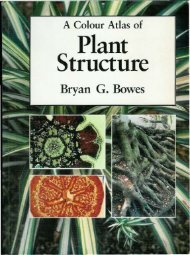Create successful ePaper yourself
Turn your PDF publications into a flip-book with our unique Google optimized e-Paper software.
activation energyrainfall, which causes leaching <strong>of</strong> limefrom the surface layers, or over acid substratasuch as granite or sand. In the acidicconditions, decomposition <strong>of</strong> organic materialin the soil is slow. Acid soils <strong>of</strong>tencontain substantial concentrations <strong>of</strong> ironand aluminum hydroxides. See brownearth; podsol.Acrasiomycota (cellular slime molds) Aclass <strong>of</strong> protoctists in the phylum Rhizopoda.Formerly considered to be fungi,they are made up <strong>of</strong> independently livingamebas that feed on bacteria, which theyingest by phagocytosis. Under conditions<strong>of</strong> food shortage or other stresses, theycome together to form a slug-like aggregation<strong>of</strong> amebas called a pseudoplasmodium,which acts like an individualorganism.acrocarpous Describing mosses inwhich the reproductive organs are borne atthe top <strong>of</strong> the main axis, which is usuallyerect, so that subsequent growth is sympodial.acrocentricSee centromere.acropetal Describing a process (such asgrowth or development) that progressesfrom the base or point <strong>of</strong> attachment, sothat the oldest parts are at the base and theyoungest are at the tip. Compare basipetal.actin A globular contractile protein (Gactin)that makes up 10–15% <strong>of</strong> the totalcell protein in eukaryotic cells. It is a majorcomponent <strong>of</strong> the CYTOSKELETON. It alsocontrols motility, cellular movements,and cyclosis. G-actin can polymerize intohelical strands that coil together to formmicr<strong>of</strong>ilaments called fibrous actin (Factin).Actinobacteria (ray fungi; actinomycetes)A phylum <strong>of</strong> Eubacteria that contains thetrue actinobacteria and the coryneformbacteria. <strong>The</strong> true actinobacteria formbranching filaments that resemble smallfungal mycelia, with hyphae usually lessthan 1.5 m m in diameter; the coryneformbacteria are rodlike structures. <strong>The</strong>Actinobacteria are distinguished by producingactinospores: entire cells encystedin thick walls to form resistant spores.actinodromous (palmate; digitate) Describinga form <strong>of</strong> leaf VENATION in whichthree or more primary veins radiate fromthe base <strong>of</strong> the lamina toward the margin,as in sycamore (Acer pseudoplatanus), resultingin a leaf that has several large lobesor several leaflets all originating at thesame point.actinomorphyactinomycetesSee radial symmetry.See Actinobacteria.actinostele A type <strong>of</strong> protostele inwhich the xylem is star shaped and thephloem lies between the points <strong>of</strong> thestar. Protosteles are found in the primaryroots <strong>of</strong> higher plants, and in some species<strong>of</strong> Lycopodium and Psilotum. Seestele.action spectrum A graph showing theeffect <strong>of</strong> different wavelengths <strong>of</strong> radiation,usually light, on a given process. It is <strong>of</strong>tensimilar to the absorption spectrum <strong>of</strong> thesubstance that absorbs the radiation andcan therefore be helpful in identifying thatsubstance. For example, the action spectrum<strong>of</strong> photosynthesis is similar to the absorptionspectrum <strong>of</strong> chlorophyll. It showsthe net assimilation plotted against wavelength.See absorption spectrum. See illustrationoverleaf.activation energy <strong>The</strong> minimum extraenergy that must be put into a system to enablea reaction to occur. It increases the energylevels <strong>of</strong> participating molecules, andhence raises their reactivity, <strong>of</strong>ten by raisingelectrons to an excited state. ENZYMESenhance reaction rates by lowering the activationenergy. This is <strong>of</strong>ten achieved bythe attraction <strong>of</strong> the reactants to the enzyme’sactive site, thus coming into closerproximity, or by the enzyme causing conformationalor electrostatic changes in oneor more <strong>of</strong> the reactants.3





